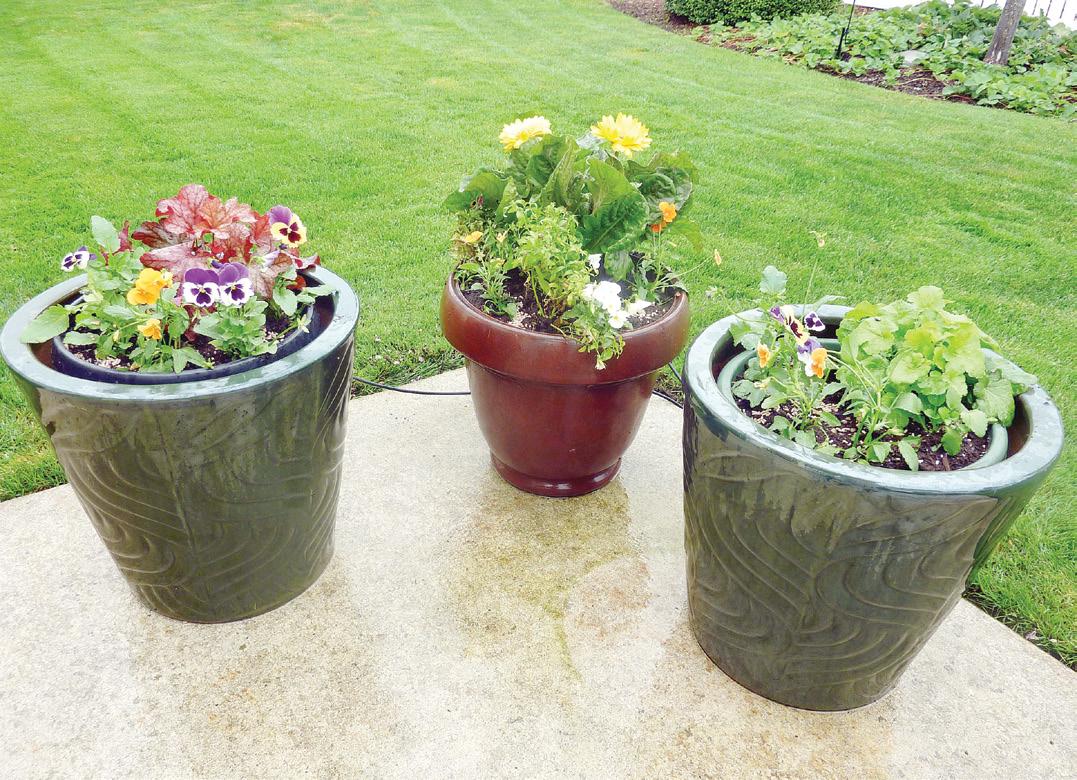
4 minute read
salvia the sage
Salvia farinacea, mealy cup sage. This is a great plant for colour into September. Salvia splendens, or scarlet sage.

Advertisement
Salvia is really sage. And sometimes sage isn’t really salvia or sage.
Confused?
Common sage and diviner’s sage are both Salvia, but Russian sage is Perovskia and Jerusalem sage is Phlomis. Salvia, Perovskia and Phlomis are all members of the Lamiacea family, also known as the mint family. It’s the true salvias we’ll consider here, though, and their versatility in the garden.
Floral sage
Salvia farinacea, or mealy cup sage, is a reliable bloomer, sending out lovely spikes of blue, both powder blue and heavenly dark blue. The leaves on this one are different from most in that they are smooth and even glossy. The flowers look a little like lavender. It is perennial in its native home of Mexico and the southern US but grow it as an annual here in Canada. One favourite cultivar is ‘Victoria’.
Salvia splendens, or scarlet sage, is another salvia that paints great swathes of crimson in formal plantings. It comes from Brazil and has been widely cultivated in the past few hundred years. You can now get S. splendens in red, purple, peach, white and pink. It’s another perennial that we grow as an annual.
Salvia sclerea, or clary sage, has interesting flower bracts that fade from a light base to a dark pink or mauve tip. Hailing from the Mediterranean basin, where it is biennial, clary has a long history in the herbal compendiums of European medicine. It is also used in aromatherapy. You can grow it from seed directly sown into your garden in early spring.
Salvia viridis, sometimes called painted sage or annual clary sage, is prized for its beautiful leafy bracts of veined pink, purple or white. It comes from the Middle East and is an annual everywhere. The colourful bracts are excellent for dried arrangements. It may self-seed in your garden, so you’ll get it year after year.
Salvia guaranitica, fascinating and beautiful, was made famous by its cultivar called ‘Black and Blue’. Extraordinarily drought tolerant, this salvia is perennial in its home of South America, but annual here. ‘Black and Blue’ is notable for its bottle-blue flowers encased in a black calyx. Once it starts flowering in mid-summer, it will keep going right until frost.
Salvia nemerosa comes from Central Europe and is the parent of many cultivars. It is hardier than most other perennial sages, maybe to Zone 3. Look for light blue ‘Bumblesky’ or the darker ‘Sensation Deep Blue’.
Hybrids. There are also several notable hybrids of salvia that have gained prominence, none more so than ‘May Night’, which may overwinter in your garden. It prefers cooler nights, which will keep the bloom for longer. ‘Madeline’ is remarkable for its blue and white blooms. ‘Hotlips’ has red and white blooms that are beautifully startling.
And that would just be the beginning of the garden salvia possibilities. But salvia is much more than just a star on the ornamental garden stage. Herbal sage
Salvia officinalis, known as common sage, is considered one of the essential herbs for British, North American, Italian and Middle Eastern cooks, used in such delicious foods as turkey stuffing and lasagna. Other

Salvia viridis. Salvia guaranitica.

varieties used for cooking include clary sage (S. sclarea) and pineapple sage (S. elegans).
You may not want to cook with diviner’s sage (S. divornum), which can be a little bit “trippy” because this sage contains a potent psychoactive compound. Native to Mexico, it has long been used by the Mazatec shamans to induce visions. It’s developed quite a following amongst the recreational drug-using segment of society since the rise in popularity of the Internet. It has low addictive properties, but several American states have criminalized its possession. Diviner’s sage is often simply referred to as salvia, so be careful what you ask for. It is also used as a diuretic.
Sage is often used for smudging, a cleansing and healing ritual involving smoke and employed by several Indigenous cultures. It is among the four sacred plants: tobacco, sage, sweetgrass and cedar. But sage is not exclusive to native Americans. An ancient Arabian proverb asks, “How can a man die when he has sage in his garden?”
Salvia is linked to salvation and both words derive from the Latin word, “salvere” for “heal” or to feel well or healthy. A sage is a wise person. Sage has been credited with slowing down the aging process. Burning sage leaves is also said to attract money. If that doesn’t work, perhaps you can use it to protect yourself from the evil eye or reverse a spell.
A 2003 double-blind scientific study showed promising results from treating mild to moderate Alzheimer’s patients with extract of common sage. After four months of daily treatment, patients treated with the sage extract showed better cognitive function. Further studies done in 2012 with S. divornum have underlined these findings. Apparently, it also holds out promise for addictions. Further studies show that sage can improve memory, attention and executive function, alertness and mood.
Furthermore, common sage has been used for centuries to reduce sweating, and no modern research has disproved its efficacy. In the twenties, people used sage to make tinctures and pour-ons to control night sweats for people with tuberculosis.
Sun-loving plants such as sage never truly thrive on a windowsill in winter because there simply isn’t enough light, but you can keep a sage plant going for several months. Give it all the direct light you can and don’t over water. h

Salvia officinalis, common sage.

Golden sage.










